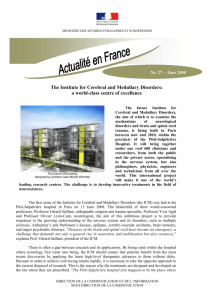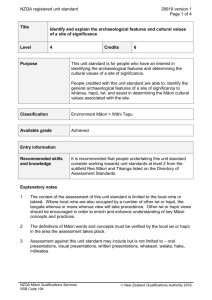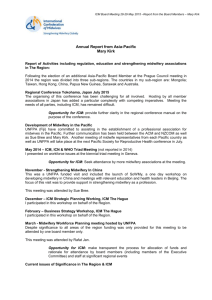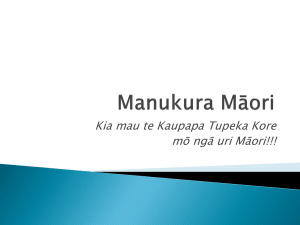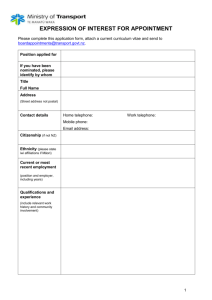Draft 9/8/04 - Integrated Catchment Management for the Motueka
advertisement
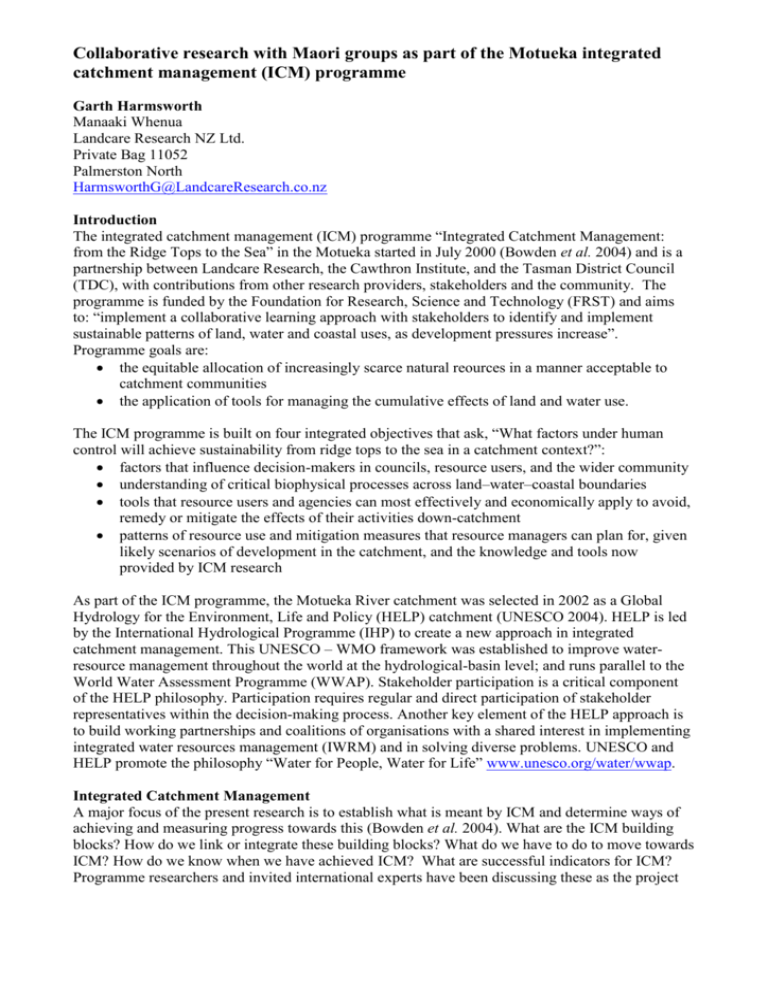
Collaborative research with Maori groups as part of the Motueka integrated catchment management (ICM) programme Garth Harmsworth Manaaki Whenua Landcare Research NZ Ltd. Private Bag 11052 Palmerston North HarmsworthG@LandcareResearch.co.nz Introduction The integrated catchment management (ICM) programme “Integrated Catchment Management: from the Ridge Tops to the Sea” in the Motueka started in July 2000 (Bowden et al. 2004) and is a partnership between Landcare Research, the Cawthron Institute, and the Tasman District Council (TDC), with contributions from other research providers, stakeholders and the community. The programme is funded by the Foundation for Research, Science and Technology (FRST) and aims to: “implement a collaborative learning approach with stakeholders to identify and implement sustainable patterns of land, water and coastal uses, as development pressures increase”. Programme goals are: the equitable allocation of increasingly scarce natural reources in a manner acceptable to catchment communities the application of tools for managing the cumulative effects of land and water use. The ICM programme is built on four integrated objectives that ask, “What factors under human control will achieve sustainability from ridge tops to the sea in a catchment context?”: factors that influence decision-makers in councils, resource users, and the wider community understanding of critical biophysical processes across land–water–coastal boundaries tools that resource users and agencies can most effectively and economically apply to avoid, remedy or mitigate the effects of their activities down-catchment patterns of resource use and mitigation measures that resource managers can plan for, given likely scenarios of development in the catchment, and the knowledge and tools now provided by ICM research As part of the ICM programme, the Motueka River catchment was selected in 2002 as a Global Hydrology for the Environment, Life and Policy (HELP) catchment (UNESCO 2004). HELP is led by the International Hydrological Programme (IHP) to create a new approach in integrated catchment management. This UNESCO – WMO framework was established to improve waterresource management throughout the world at the hydrological-basin level; and runs parallel to the World Water Assessment Programme (WWAP). Stakeholder participation is a critical component of the HELP philosophy. Participation requires regular and direct participation of stakeholder representatives within the decision-making process. Another key element of the HELP approach is to build working partnerships and coalitions of organisations with a shared interest in implementing integrated water resources management (IWRM) and in solving diverse problems. UNESCO and HELP promote the philosophy “Water for People, Water for Life” www.unesco.org/water/wwap. Integrated Catchment Management A major focus of the present research is to establish what is meant by ICM and determine ways of achieving and measuring progress towards this (Bowden et al. 2004). What are the ICM building blocks? How do we link or integrate these building blocks? What do we have to do to move towards ICM? How do we know when we have achieved ICM? What are successful indicators for ICM? Programme researchers and invited international experts have been discussing these as the project evolves, with emphasis on “developing a framework for integrating ICM research projects, to understand issues and methods needing integration to achieve catchment scale sustainability, and to improve implementation of results in policy and by resource users”. Whatever way the useful research strands are meshed, the result must lead to improved decision-making by stakeholders to achieve sustainable management of natural resources from the mountains to the sea, with a focus on water and catchment resources. ICM must then demonstrate a link between stakeholders, policy, management, science, research results and knowledge, and other research disciplines. Integration must therefore occur at a number of hierarchical, spatial, vertical, and horizontal levels that could be measured and evaluated to show effective integration of: research projects and research results (integration linkages and use of data and results within the ICM programme) research results and knowledge between Crown agencies, stakeholders, and community (integration linkages and use of data and results between projects and knowledge systems) issues across agencies, stakeholders, the community, tangata whenua active recruitment, participation of stakeholders (primary and secondary) and end users in policy, management and decision-making (including local government, stakeholders, communities, tangata whenua) relationships between researchers and action communities research results into policy and management (examples) research that responds to end-user needs and issues knowledge systems that address issues local government, stakeholders, researchers, communities and tangata whenua The other noticeable feature of ICM is that it is much larger than just a single research project or programme, and to achieve the desired outcomes involves effective integration across all sectors, policy-management-science, governance-social-political levels, research disciplines, research teams, ecosystems, and geographic areas, and includes incorporation of stakeholder and community values and goals. Collaborative research Collaborative research is an integral part of the ICM programme and is being undertaken with selected stakeholder and community groups, and the information is regularly documented and evaluated. Much of the process is action by doing, and learning based on shared knowledge, experience, and reflection. Initial work in the region focussed on identifying community and stakeholder groups, key issues, a framework for stakeholder analysis, case studies, and social learning (Allen & Kilvington 2002a), while a new phase of the research explores the role of science and other knowledge, such as increased understanding of catchment/biophysical processes, in influencing decision-making for sustainable resource use and management. A community reference group (CRG) was established in 2001 and has been used as a touchstone and interface between the ICM research and the wider community. CRG members were asked not to represent any particular interest group but rather reflect the range of community perspectives. The formation of a parallel sector liaison group has since added another dimension to integrating with, and receiving input from stakeholders. Other collaborative research is ongoing with the Tasman District Council, focussing on groups involved in biodiversity as part of the wider New Zealand Action BioCommunities programmes, and on planning and policy projects. One important result of this work in the Motueka catchment and other regions has been the learning and sharing of knowledge, particularly collaborative learning and development of projects with local indigenous Maori groups. Collaboration with Maori Along with a number of other projects (Harmsworth et al. 2002b), the ICM programme provides invaluable insights into working with Māori groups such as iwi and hapū, especially to develop collaborative projects, improve responsiveness of science to Māori needs and issues, increase capacity and participation, expand knowledge and understanding, and improve capabilities for decision-making. Māori represent only 8% of the population of the combined Tasman/Nelson/Marlborough regions, and 7% of the Tasman District population, with a total population of 41,352 (2002). Many Māori with connections to the region live in other parts of New Zealand. At the start of the project, the ICM and Manaaki Whenua science research had no proper relationship with any of the iwi and hapū groups in the area, but did have a complete set of contacts. There was, however, a commitment on the part of the research team to work with Māori to add a cultural perspective and dimension to the programme in terms of respect for indigenous rights, and in terms of improving participation and relationships under legislative process. In the region Te Tau Ihu o Te Waka a Maui (north of the South Island) there are 8 main iwi groups. To establish a solid platform on which to build relationships it was essential in the early years of the project to have complete knowledge of the history, migration, and occupation in the region and all the ancestral connections and iwi (waka) origins (Harmsworth 2001b). It was also important to develop a comprehensive understanding of recent issues, Māori organisations and governance, basic knowledge of the Treaty claims and issues, inter- and intra-political involvement between Māori groups, key people, relationships with other organisations and community groups, and resource management issues. This became the starting point for our work with regional Māori groups; and although we were starting work in the Motueka, the actual first series of hui with different iwi representatives began in Blenheim, some 100 km away, followed by Picton, Nelson, Motueka, and Takaka. Some with iwi affliliations and connections to the area were interviewed in the North Island, and a picture of the complexities of the area and its indigneous people slowly emerged and was documented. The next phase of the work moved into the Motueka catchment, and with a progressive increase in trust and respect on both sides, the relationship is now being maintained with tangata whenua (indigenous people of a specific geographic area) in the Motueka area, mainly through the Motueka Iwi Resource Management Advisory Komiti (MIRMAK), made up of representatives from Ngati Rarua, Te Atiawa, and Ngati Tama, the three main iwi. An equivalent, but slightly expanded iwi organisation sits in the Nelson region. Representatives from all these iwi work together and support each other, they are involved in a large number of activities, in planning and policy to various degrees, and work tirelessly (often voluntarily) to address a wide range of issues that cover a large area in the top of the South Island. Progress to date Since 2000 we have developed an inclusive participatory framework and process for working with iwi and hapū tangata whenua. Over this time, local iwi Māori groups have become involved in a range of ICM research activities, including the annual general meetings (AGM) held once a year since 2001 (Landcare Research 2001, 2002, 2003, 2004), the Arts-Science project (Landcare Research 2004) and “Travelling River” exhibition (Fenemor et al. 2004), a number of science/objective projects, and interaction with ICM science project leaders to access and use science information, results, and data. The first 2 years of the ICM programme work with local Maori was very much part-time and occasional, and was dedicated to building trust, respect, understanding, and goodwill. This relationship has been extended across the ICM research team, rather than to one member or one project. To date, working with iwi and hapū representatives has enabled the ICM research to identify and understand cultural issues, current iwi and hapu activities, and the complex dynamics of stakeholder relationships. To enhance our understanding of integrated catchment management and catchment processes, it has been important to consider cultural and traditional as well as scientific knowledge. A number of project steps have been developed with iwi and hapū representatives to date. Some have involved small sub-contracts to iwi and hapū members. These have included: 2000–2002: Developing a summary history of iwi and hapū in the Te Tau Ihu region, understanding dynamics between iwi and Māori organisations, origins of groups, politics, governance, relationships with the Crown (Harmsworth 2001b, 2003b). 2000–2003: Aligning ICM research to iwi needs and issues, and improving the responsiveness of the ICM research to Māori (Harmsworth 2001c) 2000–2003: Identifying and documenting regional, specific and local iwi and hapu issues (Harmsworth 2001c, 2002a, 2003a,e). 2000–2003: Identifying the interactions and relationships between agencies and groups, such as between the Crown (e.g., local government), iwi and hapū, other Māori organisations, and stakeholders (e.g., industry, community groups; Harmsworth 2002a, 2003e). 2001–2004: Identifying and documenting all current iwi and hapu activities, including knowledge systems, monitoring and resource consents, management plans, archaeological survey, cultural sites, input into policy, and decision-making issues (Harmsworth 2003e). 2002–2004: Summarising current and potential projects (e.g., nature, status, groups, location) involving iwi and hapū, iwi/hapū and the community, iwi and hapū aspirations, and specific goals for projects (e.g., biodiversity projects, cultural projects, environmental projects; Harmsworth 2003e). 2002–2004: Identifying needs for building capacity to achieve aspirations and goals (e.g., people, upskilling, training, improved access to research results, areas requiring resources, funding; Harmsworth 2003e). 2003–2004: Developing collaborative projects, action community projects, with iwi/hapū and Māori groups (Harmsworth 2003a, e). 2004–present: Exploring future research opportunities, developing joint proposals, identifying training needs with iwi/hapū and the wider community (Harmsworth 2003a, e). 2004–present: Identifying future Māori, indigenous, and international research topics that contribute to and strengthen ICM ideologies and philosophies This information has been documented in a number of reports, presentations, and papers. A focus of much of this work has been to advance iwi/hapū collaborative projects in the Motueka and surrounding districts, and to improve alignment between iwi/hapū issues and work activities, and the actual ICM research projects. Because a key part of ICM is to help improve stakeholder dialogue and decision-making processes in the catchment, it is important for the programme to support: Improved access and uptake of science knowledge results by stakeholders, and Enhance other knowledge systems that support effective decision-making. A new iwi/hapū project was written and submitted to the Foundation of Research, Science, and Technology (FRST) in February 2003. Following success in funding this has been incorporated as a small sub-contract in the ICM programme for 2003–2005. The project began in late 2003 and will help iwi/hapū, through the MIRMAK group, develop an: Iwi information system and knowledge base to underpin and improve environmental and cultural decision-making by iwi, facilitate the uptake and use of knowledge, improve engagement with stakeholder groups and researchers, and determine effective processes, systems, and best management practice for stakeholders and iwi, and promote sustainable management of natural and cultural resources. Key issues General iwi/hapū issues for the Te Tau Ihu region, particularly the Tasman district, include (Harmsworth 2003e): Relationships, partnerships (e.g., lack of a partnership model, poor understanding of the Māori worldview, cultural issues, conflicts/different views, lack of input into decisionmaking, and policy, insufficient iwi/hapū capacity to effectively engage) Loss of and damage to mauri in rivers, streams, estuaries Cultural heritage (e.g., damage, modification) Sustainable resource use (e.g., water allocation, depletion of, and misuse of natural resources) Contaminated sites (e.g. Mapua) Sediment pollution Coastal, marine issues (e.g., sewage contamination, pollution, sustainable management of coastal resources) Biodiversity issues (e.g., decreasing indigenous biodiversity, decreasing taonga species) Biosecurity (e.g., weeds and pests, 1080) More specific issues for the district and region were documented in Harmsworth (2003e). Some of the key issues identified by Te Tau Ihu iwi/hapū between 2000 and 2003 are not dissimilar to those found in other parts of the country. It is useful to note that one of the key issues was to continue to improve relationships between local government and iwi/hapū, to introduce more inclusive partcipatory decision-making, greater input into planning and policy, more effective and streamlined systems for handling resource consents, greater understanding and respect by councils for cultural issues, and to find constructive ways for improving relationships and partnerships. Most iwi/hapū around the country, including those in the Tasman District, have acknowledged the dramatic improvements in relationships and partnerships with local government since the mid1990s, especially following the RMA 1991 (Harmsworth, in prep.). However, many believe these relationships still have a long way to go; recognition and respect from local government is still not apparent, many iwi/hapū still lack the capacity to engage effectively, most iwi/hapū still feel excluded from the decision-making process, resulting in limited input into planning and policy. Most feel they spend their time reacting to other agendas and issues, rather than pro-actively dealing with issues from the inside. Main phases for building a relationship with Maori groups What we have learnt from working with Māori in the Motueka area could be applied to working with many other Māori and community groups, in New Zealand and internationally. While there are many specific protocols and lessons within distinct areas, generic steps are demonstrated. These have some alignment and similarity to those outlined by Allen et al. (2001) under the integrated system for knowledge management (ISKM) framework, and follow previous guidelines (Harmsworth 2001a, 2003c,d). The main phases we are working through are: Entry into a geographic area Relationship building Maintenance of the relationship Development of collaborative projects Identification of capacity needs and building capacity for Māori and science researchers Improved participation of Māori in projects and increased responsiveness of the science to iwi and hapū aspirations and needs Expansion of the ICM research to incorporate a cultural component. Entry into a geographic area: Making contact with key people/groups, learning local protocols, learning about key regional and local issues, understanding relationships and interaction with other key stakeholders and the community, learning historical background, ancestral lineage–whakapapa, political issues, key contacts, people, tangata whenua, holding hui, introducing the ICM research, introducing key researchers Relationship building: Attending hui, field visits, following protocol, building trust and respect, listening, sharing information, issues analysis for regional and local issues, improved alignment of ICM research to iwi/hapū and community issues Maintenance of the relationship: Understanding current work activities, field visits, regular hui, community actions, participatory research, listing potential collaborative projects, identifying potential areas for capacity building for both iwi/hapū Māori and ICM science researchers, understanding iwi/hapū/community aspirations and specific project goals Collaborative projects: Improved participation of Māori in projects and increased responsiveness of the science to iwi and hapu aspirations and needs, development of joint projects, identify potential funding sources, successful funding, improved resourcing to iwi/hapū, project development, recognising wider (e.g., cultural, local) knowledge systems, iwi/hapū led actions and research, partnerships Identification of capacity needs: Working together, sharing resources, exchanging information, identifying areas to build capacity for iwi/hapū, for ICM research team, for other stakeholders, facilitate education programmes, increase training and upskilling within collaborative projects, enhance and expand dialogue with stakeholders, build increased respect and recognition of different worldviews Improved participation of Māori groups: Increased confidence, trust and understanding, collaborative projects, collective goals, improved working and coordination with stakeholder and community groups, development of iwi information systems, improved access to ICM science knowledge and research results, shared information, improved end-user uptake of science results, build expanded knowledge systems to underpin ICM, integrate knowledge systems, increased responsiveness of the science to iwi and hapū aspirations and needs Expansion of the ICM research: Developing case studies, adding an indigenous cultural dimension to ICM, using Māori knowledge (mātauranga) in ICM, exploring new cultural knowledge systems and their application to research, management and policy, knowledge integration frameworks and models, evaluating and measuring ICM performance, providing successful models of collaborative research and learning, identifying community goals and actions, developing good practice, comparisons with other national and international ICM research, pragmatic, conceptual and theoretical contributions to ICM philosophies, improved decision-making by groups working in ICM This work is also a catalyst to improving relationships between Māori groups, community groups, stakeholders, local government, and researchers. The future The Māori work presently being carried out is a small but significant component of the ICM programme in the Motueka. Our ultimate goal is to increase understanding and decision-making (by all groups – stakeholders, local government, community, tangata whenua) to implement sustainable patterns of land, water and coastal uses, as development pressures increase. The future work will have three main strands: To link research in the Motueka to national and international collaborative research (e.g. collaborative learning and relationship development lessons, collaborative evaluation studies) other agency studies, including practical social–cultural learning case studies with communities and stakeholders, and theoretical and academic studies To link social–cultural learning from iwi/hapū to international research in indigenous studies, such as indigenous knowledge systems and sustainable development http://www.nuffic.nl/ik-pages/ikww/index.html To link the Motueka research to other environments, such as urban, and apply approaches, theory, and learning with communities, stakeholders, and tangata whenua to more densely populated and highly modified catchments and ecosystems Indicators that will determine whether we are successful in achieving and implementing ICM include: Improved relationships and interaction between iwi/hapū and other stakeholder groups Links and continuing relationships between iwi/hapū and ICM researchers Access and use of science knowledge from the ICM programme Increased access to knowledge and information from stakeholder groups, such as local and central government Uptake, use and understanding of research results related to issues Science knowledge that helps iwi/hapū better understand and address issues and make decisions Development of iwi/hapū knowledge and information systems that can be used for a wide variety of tasks Integrated research results that are accesible, and in a form that can be readily understood and used Greater understanding of cultural issues and knowledge by stakeholder groups, researchers, and the way that affects wider decision-making Recognition and respect for Maori values and knowledge (mātauranga) Responsive and flexible ICM research to address iwi/hapū issues Increased capacity for iwi/hapū to more effectively engage with stakeholders and researchers Collaborative projects between iwi/hapū, stakeholders and researchers Recognition of the important role of tangata whenua in the wider community and by local government Greater input by iwi/hapū and communities into planning and policy It is important to recognise in ICM that failure is also an important part of collaborative learning – as long as the learning is acted on in a constructive way. An ideal end point for ICM will be effective participation by all groups, including tangata whenua, in planning, policy and decisionmaking. In the region, and particularly in the Tasman district, local iwi and hapū representatives are already active in making submissions and making recommendations on a wide range of issues. This includes giving resource consent approval and helping to resolve many local government and wider community issues. A large amount of their present work is in trying to improve systems and processes for decision-making, and to increase cultural understanding about issues (Walker et al. 2003). MIRMAK members and similar Maori organisations in the region are also very active in working with the wider community and local government on developing mutually beneficial projects, such as restoration, biodiversity enhancement, environmental monitoring, and development of indicators. What the ICM programme provides, is an enormous scope for knowedge integration to help them contribute to issues, a catalyst for links and relationships between stakeholders, a facility to attract resources to help build capacity and help engagement in research, the development of their own information systems and cultural knowledge repositories, and the development of collaborative projects that foster good relationships with other groups and local government. Projects that lead to cohesive community actions can achieve goals towards the sustainable patterns of land, water and coastal uses (e.g. can include restoring indigenous biodiversity, waste water treatment, best management practices, sustainable use of water resources). Summary Through ICM we are developing an environment for social and cultural learning, collaborative research, and partnerships to improve: the engagement between science, stakeholder groups, the community, and tangata whenua the social environment for the uptake of science information Much historical, social, economic, and biophysical information has already been collated and generated on the Motueka catchment to date (Basher et al. 2003), and new research results are continually documented and posted on web sites. Iwi/hapū regard these papers and technical reports, along with the ICM web site http://icm.landcareresearch.co.nz/ as very useful. To be successful, ICM must respond to a large number of stakeholder groups, community groups, and tangata whenua. Knowledge integration through ICM can help create awareness of issues, facilitate technical understanding, find balanced solutions to complex problems and issues, and make a significant contribution, through people and organisations, to the sustainable management of natural resources in catchments. Māori knowledge, and increased understanding of Māori environmental perspectives can make a significant contribution to ICM research in New Zealand. Māori problem solving and issues analysis often takes place within indigenous frameworks consistent with ICM holistic concepts (Harmsworth 2002b; Walker et al. 2003). There is a role for using Māori knowledge (both contemporary and traditional) in ICM to: understand the spatial and temporal variation of cultural values improve physical and cultural resource management resolve conflict understand cultural perspectives of an issue find solutions to specific tangata whenua and community issues improve understanding of catchment, biophysical processes, and environmental change improve decisions on resource allocation and use build relationships and partnerships that can achieve sustainable management of natural resources build capacity for iwi/hapū groups and the wider community. To date many iwi/hapū issues, activities and projects have been documented and summarised (Harmsworth et al. 2003e), which will lead to future work with iwi/hapū, stakeholders, and the community. The next phase of the work will continue to develop collaborative Māori and community projects (e.g., biodiversity–cultural projects), help build iwi/hapū capacity (both individual and social), and improve uptake and use of science results, and research responsiveness. It is hoped these strands will also facilitate community initiatives that benefit stakeholders and the wider community, and fulfil the role and status of tangata whenua in the region. On the collaborative learning side, this case study is linked to other national and international examples, and improves the way we interact and work with people to bridge the gap between science and end users, such as communities. Although much of the research explained here has focussed on working with Māori, it is important to learn from working with indigenous minority groups such as iwi/hapū, as well as larger population examples and primary stakeholder groups. Parallel work is being carried out in the ICM programme with other communities and stakeholders (Allen & Kilvington 2002a,b), as is the development with local government of good practice guidelines for working with iwi/hapū (Harmsworth, in prep). Acknowledgements We thank the Iwi Resource Management Advisory Komiti (MIRMAK), comprising representatives from Ngāti Rarua, Te Atiawa, and Ngāti Tama, the three main Motueka-Nelson iwi, for their participation. We also thank other researchers in the ICM programme, including Andrew Fenemor who leads the current research, for his support for Māori research and its inclusion in the programme. References Allen, W.J.; Kilvington, M.J. 2002a: How well are we working together? Learning the answers through innovative evaluation approaches. Presentation, ICM research programme, October 2002 AGM. http://icm.landcareresearch.co.nz/library/presentations/agm2002/AGM2002_social_learning.pdf Allen, W.J.; Kilvington, M.J. 2002b: Sustainability science: introducing collaborative learning processes to environmental research programmes. Paper presented at the Berlin conference on the Human Dimensions of Environmental Climate Change 6–7 December 2002. Collaborative learning web site: http://www.landcareresearch.co.nz/research/social/ Basher, L.R. comp. 2003: The Motueka and Riwaka catchments: A technical report summarising the present state of knowledge of the catchments, management issues and research needs for integrated catchment management. Lincoln, Landcare Research New Zealand. 120 p. Bowden, W.B.; Fenemor, A.; Deans, N. 2004: Integrated Water and Catchment Research for the Public Good: The Motueka River-Tasman Bay Initiative, New Zealand. Water Reseources Development. Vol 20, No.3. 311–323. Fenemor, A.D.; Atkinson, M.; Peacock, S. 2004: Travelling River – a collaboration of artists, scientists and the people of the Motueka River catchment. Catalogue of the exhibition published by Mountains-to-the-Sea project, Landcare Research. Harmsworth, G.R. 2001a: A collaborative research model for working with iwi: discussion paper for FRST. Landcare Research Contract Report LC 2001/119 for FRST (unpublished). 29 p. http://www.landcareresearch.co.nz/research/social/iwimodel.asp Harmsworth, G.R. 2001b: Māori migration and history in Te Tau Ihu o Te Waka a Maui. ICM web site. http://icm.landcareresearch.co.nz/science_themes/human-dimensions/maori_values.htm Harmsworth, G.R. 2001c: Identifying and meeting Māori needs: Tangata whenua issues. Presentation given at the ICM Motueka Programme AGM, 9–10 October 2001, Nelson– Motueka. http://icm.landcareresearch.co.nz/library/presentations/agm2001/annual%5Fgeneral%5Fmee ting%5Foctober%5F2001.htm. Harmsworth, G.R. 2002a: Finding common ground in our common ground: identifying opportunities for collaborative learning in Māori-Pakeha environmental initiatives. Presentation given at the ICM Motueka programme AGM, 22 October 2002, Nelson– Motueka. http://icm.landcareresearch.co.nz/library/presentations/agm2002/public_presentations.htm Harmsworth, G.; Warmenhoven T.; Pohatu, P.; Page, M. 2002b: Waiapu Catchment Technical Report: Māori community goals for enhancing ecosystem health. Foundation for Research, Science, and Technology (FRST) contract TWWX0001. Landcare Research Contract Report LC 0102/100 for Te Whare Wānanga o Ngāti Porou, Ruatorea (unpublished). 185 p. Harmsworth, GR. 2003a: Iwi values and collaboration. Power point presentation slides. ICM, AGM 21–23 October 2003. Presentations – abstracts and posters, Nelson–Motueka. http://icm.landcareresearch.co.nz/2003_agm_-_project_abstracts.htm http://icm.landcareresearch.co.nz/library/Presentations/agm2003/ICM_AGMOct2003.pdf Harmsworth, G.R. 2003b: Maori and ICM-Aotearoa. ICM web site. http://icm.landcareresearch.co.nz/science_themes/human-dimensions/maori_and_icm_aotearoa.htm Harmsworth, G.R. 2003c: Guidelines for engaging iwi and hapu groups in Integrated Catchment Management research. NZARM broadsheet: 37–40. Harmsworth, G.R. 2003d: Guidelines for engaging iwi/hapu: Guidelines for engaging iwi and hapu groups in Integrated Catchment Management Research. ICM web site. http://icm.landcareresearch.co.nz/science_themes/humandimensions/guidelines_for_engaging_iwi_hapu.htm Harmsworth, G.R. 2003e: Motueka and Regions Tangata Whenua Resource Management Group: research, issues, management and monitoring in Te Tau Ihu. Landcare Research contract report LC/0203/085. 88 pp. Report updated November 2003. Harmsworth, G.R. (in prep): Good practice guidelines for working with tangata whenua and Maori organisations: consolidating our learning. Report for the ICM web site. 41 pp. Landcare Research 2001: ICM programme AGM, 9–10 October 2001. Nelson–Motueka. http://icm.landcareresearch.co.nz/library/presentations/agm2001/annual%5Fgeneral%5Fmeeting%5 Foctober%5F2001.htm. Landcare Research 2002: ICM programme AGM 22 October 2002. Nelson–Motueka. http://icm.landcareresearch.co.nz/library/presentations/agm2002/public_presentations.htm Landcare Research 2003: ICM programme AGM 21–23 October 2003. Nelson–Motueka. http://icm.landcareresearch.co.nz/2003_agm_-_project_abstracts.htm Landcare Research 2004: The Mountains to the Sea Arts–Science project. ICM programme. http://icm.landcareresearch.co.nz/science_themes/humandimensions/arts_and_science_collaboration.htm Walker, D.; Bunt, W.; Stephens, M. 2003: A cultural impact assessment of the Nelson Sewerage Ponds Scheme and ponds: An assessment of effects on the values of the Tangata Whenua and recommendations for change. For Ngāti Koata, Ngāti Rarua, Ngāti Tama, Te Runanga o Toa Rangātira and Te Atiawa. Unpublished report. UNESCO 2004: Hydrology for the environment, life and policy web site. http://portal.unesco.org/sc_nat/ev.php?URL_ID=1205&URL_DO=DO_TOPIC&URL_SEC TION=201&reload=1022252886

